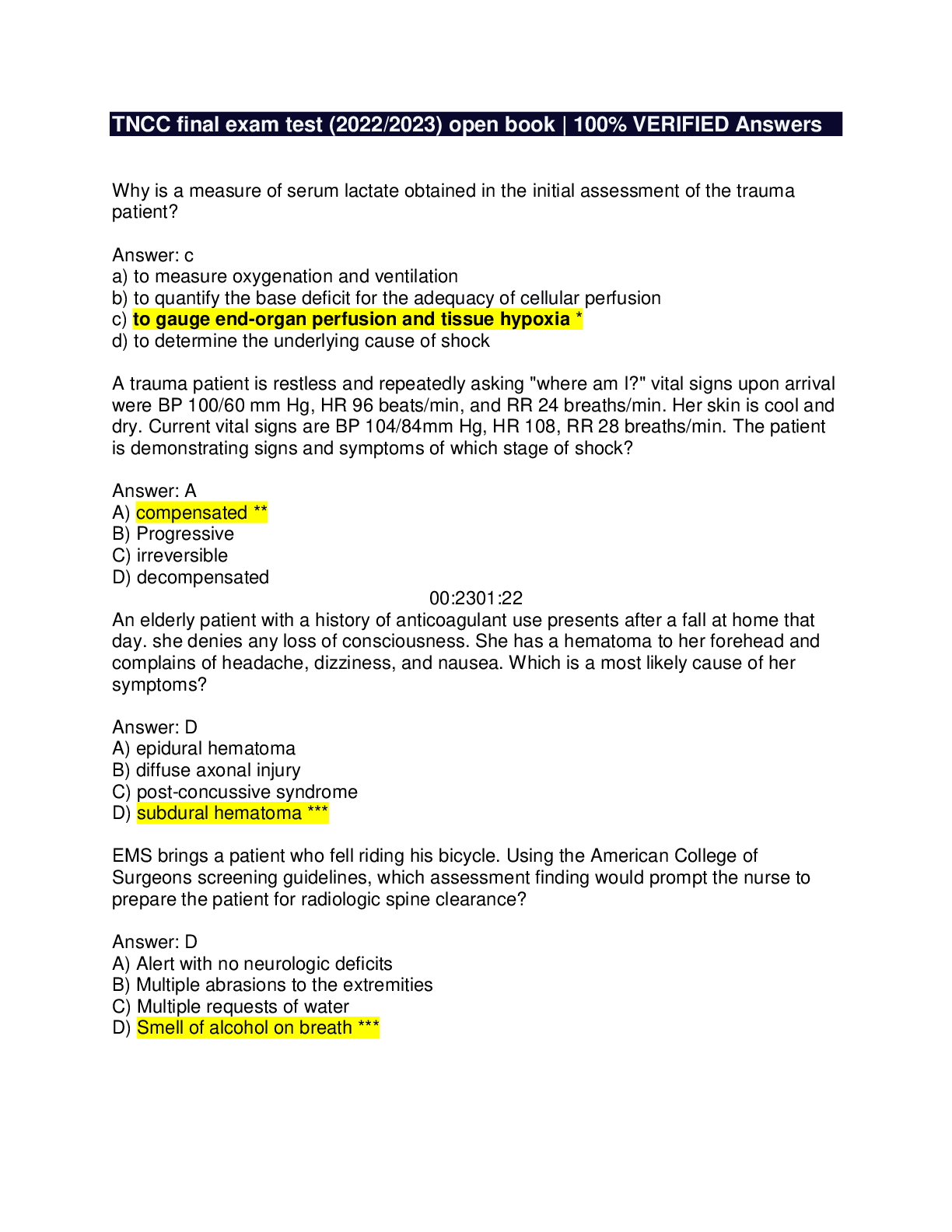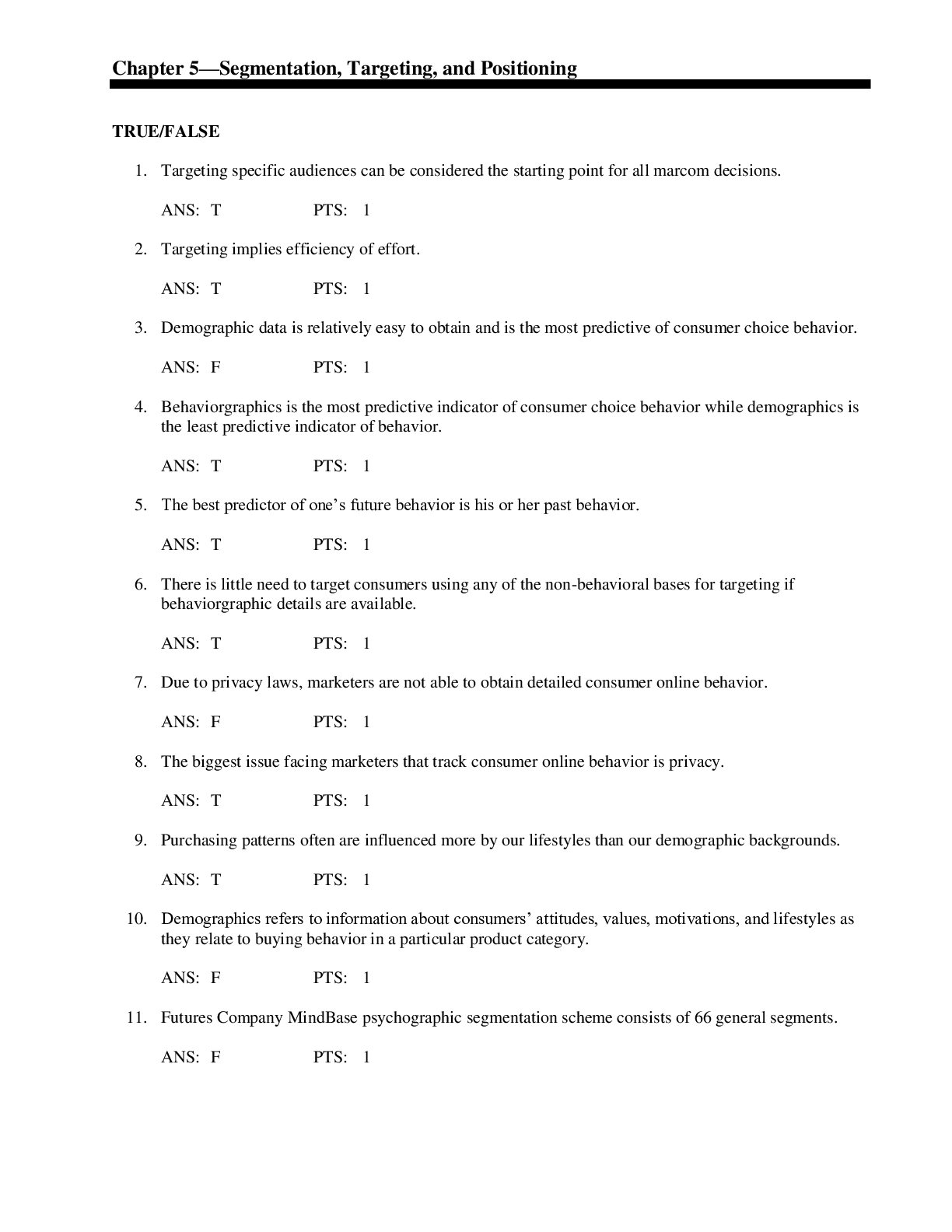*NURSING > QUESTIONS & ANSWERS > PED 240 Exam 2 leadership ATI (30 OUT OF 30) | Questions and Answers | 100% Guaranteed Pass | GRADED (All)
PED 240 Exam 2 leadership ATI (30 OUT OF 30) | Questions and Answers | 100% Guaranteed Pass | GRADED A
Document Content and Description Below
PED 240 Exam 2 leadership ATI (30 OUT OF 30) 1. Accrediting agencies such as The Joint Commission address staffing by: a. imposing maximum staffing levels. b. requiring a specific staff mix. c. ... stipulating nurse-patient ratios. d. looking for evidence that patients receive satisfactory care. ANS: D 2. Customer satisfaction is primarily based on: a. access to modern, up-to-date facilities. b. availability of an extensive menu selection. c. personal interactions with employees. d. having to undergo fewer invasive procedures. ANS: C 3. Nurses on a unit provide personal hygiene, administer medications, educate the patient and family about treatments, and provide emotional support. These nurses provide patient care based on which nursing delivery system? a. Total patient care b. Partnership nursing c. Team nursing d. Functional nursing ANS: A 4. A patient is admitted with pneumonia. The case manager refers to a plan of care that specifically identifies dates when supplemental oxygen should be discontinued, positive-pressure ventilation with bronchodilators should be changed to self-administered inhalers, and antibiotics should be changed from intravenous to oral treatment, on the basis of assessment findings. This plan of care is referred to as a: a. patient classification system. b. clinical pathway. c. patient-centered plan of care. d. diagnosis-related group (DRG). ANS: B 5. The nurse manager determines that four RNs, five LPN/LVNs, and two Unlicensed assistive personnel (UAP) are required per shift to meet the needs of the patient population on the unit, according to acuity and census. The nurse manager is concerned with: a. assignments. b. staffing. c. output. d. productivity. ANS: B 6. A nurse manager is mentoring a novice nurse manager in determining staffing needs. The mentor explains, “We must determine the acuity level of the patient by: a. assessing patient satisfaction with nursing care.” b. quantifying the amount and intensity of care required.” c. examining the skill mix and educational preparation of the staff.” d. determining the number of hospital days required by the patients.” ANS: B 7. The nurse manager is planning staffing levels and realizes that the first step is to: a. know the intensity of care needed by patients according to physical and psychosocial factors. b. examine the educational level of the staff. c. assess the skill level of caregivers. d. review the budget to determine the financial consequences of past staffing patterns. ANS: A 8. When deciding which staffing option to use on a nursing unit that will open soon, the manager realizes that: a. continuity of care is enhanced and errors are reduced when nurses provide care over longer shifts and consecutive workdays, such as 12-hour shifts on 3 consecutive days per week. b. the use of part-time nurses provides the variability needed to meet diverse patient needs. c. satisfaction of the staff equates to satisfaction of patients. d. nurses provide the same level of care, regardless of the work environment. ANS: C 9. A nurse makes patient care assignments as follows: RN 1 has rooms 200-210; RN2 has rooms 211- 221; RN3 has room 222-232. The two unlicensed assistive personnel have half the rooms, with one assigned to 200-215 and the second to 216-232. The care delivery model used in this situation is: a. team. b. primary. c. partnership. d. modular. ANS: D 10. A nurse responsible for staffing a medical-surgical unit must consider: (Select all that apply.) a. the patient census. b. She changed this option to “staff breaks” c. complexity of care required. d. educational level of all staff. e. task preferences of the nurses. …I chose all except E 11. A nurse has been asked to serve as the charge nurse on the evening shift. The agency where the nurse is employed is considering unionization. If the charge nurse position is accepted, this nurse: a. can be represented by the union because charge nurses are not considered part of the management team. b. is part of the management team, so union participation would be a conflict of interest. c. can file a grievance that will be arbitrated automatically by the union. d. is ineligible for collective bargaining activities that deal with unfair labor practices. ANS: A 12. Nurses in a nonprofit hospital have expressed an interest in forming a union to secure fair wages and ensure client safety. To form a core support group of nurses, the union organizer can conduct meetings to gather initial information: a. away from the worksite with a group of managers to learn both sides of the situation. b. at the worksite with staff nurses who are respected leaders. c. in homes or local businesses with staff nurses. d. after photographing management meeting to discuss their strategies to decrease interest in unionization. ANS: C 13. Mandatory overtime and reduction in RN staff have resulted in decreased client satisfaction and a sentinel event. Management is unwilling to discuss a change in staffing, and collective bargaining interest is sparked. A nurse is approached to sign a union authorization card. If signed, the card: a. authorizes the union to serve as his/her legal representative. b. indicates that the person is requesting additional information about collective bargaining. c. indicates the nurse desires to share information about grievances. d. gives permission for union dues to be deducted from pay. ANS: A 14. A concern that nurses were being asked to perform tasks that went beyond the state’s nurse practice act was brought to the union’s attention. Nurses were informed that either mediation or binding arbitration will be used to resolve the issue. A novice nurse asks about the difference between these techniques and is informed that: a. mediation is sanctioned by the National Labor Relations Board (NLRB) to formally discuss concerns with management and labor. b. binding arbitration is a formal discussion between labor and management in which the arbitrator’s recommendations are compulsory. c. mediation uses a trained person to negotiate a legally binding plan. d. binding arbitration requires both labor and management to participate in discussions on the least destructive approach to allow self-governance by employees. ANS: B 15. A nurse is interested in working in a large trauma center that is unionized but does not want to join the union or pay fees. She accepts the position but is not required to join or pay fees to the union based on which law? a. National Labor Relations Act b. Right-to-Work law c. National Labor Relations Act d. Taft-Hartley Act ANS: B 16. A group of nurses are assembling outside a hospital protesting the use of foreign nurses after several nurses were terminated due to what the hospital called recurring “decreased census.” The nurses carry signs with messages asking potential patients to seek care elsewhere. The local newspaper picked up the story, and the hospital is receiving negative press. The nurses are participating in: a. picketing. b. collective bargaining. c. a strike. d. arbitration. ANS: A 17. Mandatory overtime and reduction in RN staff have resulted in decreased client satisfaction and a sentinel event. Management is unwilling to discuss a change in staffing, and collective bargaining interest is sparked. During the pre-election period, what actions by management are prohibited? (Select all that apply.) a. Seek individuals to spy on co-workers who are possible union supporters. b. Photograph employees participating in information sessions about unionization. c. Visit managers outside work to gain their perception of popularity of unionization. d. Threaten that, should the union win, the company will relocate when there is no intention to relocate. e. Require employees to declare their position on unionization prior to pick up paychecks. ANS: A, B, D, E 18. Consumers are concerned with security issues related to their confidential health information being placed in an electronic health record (EHR). However, when the security of the EHR is compared with that of paper-and-pencil records, the EHR is: a. more secure. b. less secure. c. equivalent. d. not comparable with the paper-and-pencil record. ANS: A 19. When paper-and-pencil medical records are compared with computer-based records: a. paper-and-pencil records provide controls to determine who has viewed the health information. b. information contained in a paper-and- pencil record has the capability of being more in-depth than that found in computer-based records. c. patients have the right to know that the confidentiality of their records is strictly maintained, regardless of the type of medical record used. d. patients must sign for each item of information released on the computer record. ANS: C 20. A nurse is preparing a scholarly publication on the prevalence of hepatitis A worldwide. The most efficient and effective means of conducting an Internet search to gather information for this publication is to use: a. a search engine such as Google or Yahoo. b. a consumer health website. c. a decision support system. d. MEDLINE database. ANS: D 21. An advanced practice nurse inputs into a computer software program the following clinical manifestations: open wound with tibia exposed, petechial hemorrhage, and temporary loss of consciousness. The computer diagnosis of fat emboli is generated by a system known as: a. decision support. b. telehealth. c. robotic technology. d. biometric technology. ANS: A 22. A nurse is preparing a presentation using different websites to collect information. The nurse is concerned that contact information and the author’s credentials are not listed for one of the websites reviewed. Which criterion required to establish a reputable website is missing? a. Authority b. Objectivity c. Usability d. Currency ANS: A 23. The Institute of Medicine (IOM) (2003) recommends that EHR systems offer eight functionalities. A patient has a severe allergy to eggs and penicillin. Which of the eight functions of the EHR would address sharing this information? a. Health information and data capture b. Results/data management c. Provider order entry management d. Clinical decision support ANS: A 24. What do you do to prevent VAP? -Oral care with chlorhexidine 25. What do you NOT do to prevent CAUTI? -Wipe meatus back to front 26. Fall risk SATA -Keep by nurse’s station -Bed in low position -Toilet frequently …I didn’t select restraints or re-position every 2 hours (that’s for pressure ulcers) 27. Consent SATA -Pt should know risks -Pt should know alternative treatments -Pt should understand consent form -Pt should know they can refuse … I didn’t select “names of all interdisciplinary staff on consent form” (idk?) 28. Privacy SATA -Keep files in a safe/ secure place -Only look at charts you actually need - I forget but there’s definitely a third answer… it may be that the nurse has a password …I didn’t select “minimize screen” (cause you should log out) and didn’t choose “throw Pt papers in trash bin (should shred them). 29. Which is violation of HIPPA? -Overhear nursing student at clinical looking through chart of a Pt they don’t have 30. What happens after the strike vote passes? -Union has power to strike if negotiations don’t start happening 31. One answer is that healthcare workers are the more likely to breech HIPPA by viewing EHR that they shouldn’t be accessing [Show More]
Last updated: 2 years ago
Preview 1 out of 8 pages

Buy this document to get the full access instantly
Instant Download Access after purchase
Buy NowInstant download
We Accept:

Reviews( 0 )
$7.50
Can't find what you want? Try our AI powered Search
Document information
Connected school, study & course
About the document
Uploaded On
May 17, 2021
Number of pages
8
Written in
Additional information
This document has been written for:
Uploaded
May 17, 2021
Downloads
0
Views
87


 And LETRS Unit 8 Final Assessment Test.png)























